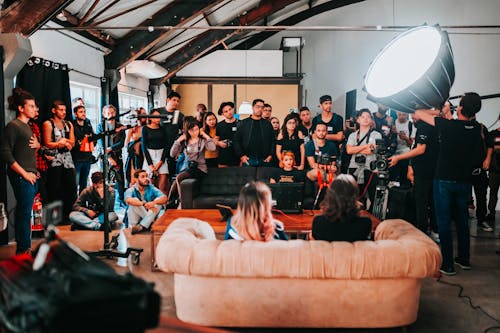Note: You can read the full guide and resources in the carousel above ☝️
LinkedIn is not only a platform to do marketing but also a place to find information about doing your marketing. Just like on any other social media platform, LinkedIn can give you access to a powerful depository of market information through its content discovery channels.
And just like on basically any other social networking site, this content discovery channel can be found right after you sign into your account, in the form of the updates feed. On LinkedIn, this feed follows a different approach because, while it might be used to share updates from the platform and its members, it does so only with serious, relevant content.
The basic functionality of this feed then is to show you what is trending and
what is being shared both by your connections and content creators, and if you
pay attention to the descriptions on top of each post you will find that a lot of
these content pieces are being promoted on your feed in favor of other
marketers that are targeting you as a potential lead, much like you would do as
well.
The good news about this is that you can use all this information as market
research data that you can later use for your own campaigns, which is as useful
as it is practical because, as you can see, you can easily access all this information
by simply scrolling down.
The first thing that you should note is that this feed will show you updates from pages and profiles that you follow. This information is important especially if you follow mostly companies in your niche, as the way in which LinkedIn members interact with this information will give you great insights into what is trending among your potential audience.
There are four specific types of content that will be continually featured on your LinkedIn feed. The first type of content is “recommended” content, which can be labeled as “trending”, “recommended for you” or “popular”.
These content pieces are curated both by LinkedIn’s editorial team and by the platform’s algorithm to serve only the most appropriate content to each member. The second type of content is content that is trending at the moment and that is labeled as “latest news” or as “mentioned in the news”.
Unlike Recommended content, these posts are generally not curated or targeted towards any particular member based on its profile and its information, and they are only served for informational purposes, and they are also not intended to represent a given company’s activities or point of view.
Now, “sponsored” content are content pieces that are intended to raise awareness about organizations, products, services or brands. In short, they are advertised material that is served either to members that follow a company page or that fit the criteria of an advertiser.
These content pieces are not intrusive and are designed to allow companies to build relationships and to generate quality leads by promoting content to people that would be difficult to reach otherwise.
As you can see, all the content that appears in your feed is relevant and customized according to your profile, and you can always manage the content that appears in your feed by hiding posts, by unfollowing companies that do not show you relevant content and by reporting content that might be inappropriate.
Remember that push notifications and emails are part of the content on your feed, so make sure to leverage the information on your feed to see what’s trending in the world of professional marketing on social media!
Read more: You can read the full guide and resources in the carousel above ☝️


![[LinkedIn Success Guide] UNIT 10: USING THE LINKEDIN FEED FOR MARKET RESEARCH](https://blogger.googleusercontent.com/img/b/R29vZ2xl/AVvXsEhaKrCncL-6F0biH7-PRndSRv1_HTZbLA6rDd69KdwHLQ3C6_pWvrPV0J3jcjj5nYwWO4573tHHI7vCPFVuKM7de__zalLyGXn8XJ-FC_tB3LGnj3ZeLHPIIwh3EuGBZ5bFdofUDWOtGMIw/s72-c/Copy+of+Untitled+%252811%2529.png)





.png)
No comments:
Post a Comment